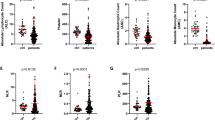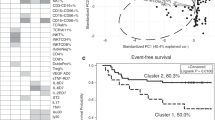Abstract
Acute GVHD (aGVHD) is a serious complication after allogeneic SCT (allo-SCT). However, an adequate immunological index is not yet available for assessing its severity. We analyzed the fraction of cutaneous lymphocyte antigen (CLA)+ cells in peripheral blood T and natural killer (NK) cells in 33 patients and evaluated its association with aGVHD. The CLA+ T-cell fraction often increased 3–7 days before the onset of aGVHD, and the maximum percentage of CLA+ T cells in grades II–IV aGVHD cases was significantly higher than that in grade 0 or I aGVHD (P<0.01). When the cutoff value of the maximum CLA+ T-cell percentage was set at 20%, any higher percentage was a significant risk for the development of severe aGVHD (P<0.0001). The maximum CLA+ T-cell percentage was significantly correlated with a high body temperature, low percutaneous oxygen saturation, and fibrinogen/fibrin degradation product D-dimer level. The post-allo-SCT CLA+ T cells exhibited a high ability to produce IL-2 and IFN-γ, and may be the effectors and immunological markers for aGVHD. The CLA+ NK-cell-fraction steadily increased 2–4 weeks after allo-SCT but was not influenced by aGVHD. The CLA+ T-cell percentage may predict the development of severe aGVHD in clinical settings.
This is a preview of subscription content, access via your institution
Access options
Subscribe to this journal
Receive 12 print issues and online access
$259.00 per year
only $21.58 per issue
Buy this article
- Purchase on Springer Link
- Instant access to full article PDF
Prices may be subject to local taxes which are calculated during checkout





Similar content being viewed by others
References
Sullivan KM . Graft-vs-Host Disease. In: Blume KG, Fornman SJ, Applebaum FR (eds). Thomas' Hematopoietic Cell Transplantation, 3rd edn. Blackwell: Oxford, 2004, pp 635–664.
Ferrara JLM, Deeg HJ . Graft versus host disease. N Engl J Med 1991; 324: 667–674.
Goker H, Haznedaroglu IC, Chao NJ . Acute graft-vs-host disease: pathobiology and management. Exp Hematol 2001; 29: 259–277.
Ferrara JL . Pathogenesis of acute graft-versus-host disease: cytokines and cellular effectors. J Hematother Stem Cell Res 2000; 9: 299–306.
Hill GR, Crawford GM, Cooke KR, Brinson YS, Pan L, Ferrara JL . Total body irradiation and acute graft-versus-host disease: the role of gastrointestinal damage and inflammatory cytokines. Blood 1997; 90: 3204–3213.
Ferrara JL, Cooke KR, Teshima T . The pathophysiology of acute graft-versus-host disease. Int J Hematol 2003; 78: 181–187.
Nestel F, Kichian K, You-Ten K, Desbarats J, Price K, Lapp W et al. The role of endotoxin in the pathogenesis of acute graft-versus-host disease. In: Ferrara JL, Deeg HJ, Burakoff SJ (eds). Graft-vs-Host Disease, 2nd edn. Marcel Dekker Inc.: New York, 1996, pp 513–516.
Butcher EC, Williams M, Youngman K, Rott L, Briskin M . Lymphocyte trafficking and regional immunity. Adv Immunol 1999; 72: 209–253.
Campbell DJ, Butcher EC . Rapid acquisition of tissue specific homing phenotypes by CD4(+) T cell activated in cutaneous or mucosal lymphoid tissue. J Exp Med 2002; 195: 135–141.
Picker LJ, Treer JR, Ferguson-Darnell B, Collins PA, Bergstresser PR, Terstappen LW . Control of lymphocyte recirculation in man. II. Differential regulation of the cutaneous lymphocyte-associated antigen, a tissue-selective homing receptor for skin-homing T cells. J Immunol 1993; 150: 1122–1136.
Fuhlbrigge RC, Kieffer JD, Armerding D, Kupper TS . Cutaneous lymphocyte antigen is a specialized form of PSGL-1 expressed on skin-homing T cells. Nature 1997; 389: 978–981.
Berg EL, Yoshino T, Rott LS, Robinson MK, Warnock RA, Kishimoto TK et al. The cutaneous lymphocyte antigen is a skin lymphocyte homing receptor for the vascular lectin endothelial cell-leukocyte adhesion molecule 1. J Exp Med 1991; 174: 1461–1466.
Leung DY, Gately M, Trumble A, Ferguson-Darnell B, Schlievert PM, Picker LJ . Bacterial superantigens induce T cell expression of the skin selective homing receptor, the cutaneous lymphocyte-associated antigen, via stimulation of interleukin 12 production. J Exp Med 1995; 181: 747–753.
Tsuchiyama J, Yoshino T, Toba K, Harada N, Nishiuchi R, Akagi T et al. Induction and characterization of cutaneous lymphocyte antigen (CLA) on natural killer cells. Br J Hematol 2002; 118: 654–662.
Faaij CM, Lankester AC, Spierings E, Hoogeboom M, Bowman EP, Bierings M et al. A possible role for CCL27/CTACK-CCR10 interaction in recruiting CD4+ T cells in human graft-versus-host disease. Br J Hematol 2006; 133: 538–549.
Scharf SJ, Smith AG, Hansen JA, McFarland C, Erlich HA . Quantitative determination of bone marrow transplant engraftment using fluorescent polymerase chain reaction primers for human identity markers. Blood 1995; 85: 1954–1963.
Andrew DP, Ruffing N, Kim CH, Miao W, Heath H, Li Y et al. C-C chemokine receptor 4 expression defines a major subset of circulating nonintestinal memory T cells of both Th1 and Th2 potential. J Immunol 2001; 166: 103–111.
Farrell AM, Antrobus P, Simpson D, Powell S, Chapel HM, Ferry BL . A rapid flow cytometric assay to detect CD4+ and CD8+ T-helper (Th) 0, Th1 and Th2 cells in whole blood and its application to study cytokine levels in atopic dermatitis before and after cyclosporin therapy. Br J Dermatol 2001; 144: 24–33.
Ohara T, Koyama K, Kusunoki Y, Hayashi T, Tsuyama N, Kubo Y et al. Memory functions and death proneness in three CD4+CD45RO+ human T cell subsets. J Immunol 2002; 169: 39–48.
Beilhack A, Schultz S, Baker J, Beilhack FG, Nihsimura R, Baker EM et al. Prevention of acute graft-versus-host disease by blocking T-cell entry to secondary lymphoid organs. Blood 2008; 111: 2919–2928.
Anasetti C, Velardi A . Hematopoietic cell transplantation from HLA partially matched related donors. In: Blume KG, Fornman SJ, Applebaum FR (eds). Thomas' Hematopoietic cell transplantation, 3rd edn. Blackwell: Oxford, 2004, pp 1116–1131.
Hsieh CS, Macatonia SE, Tripp CS, Wolf SF, O'Garra A, Murphy KM . Development of Th-1 CD4+ cells through IL-12 produced by Listeria-induced macrophages. Science 1993; 260: 547–549.
Scott P . IL-12: initiation cytokine for cell mediated immunity. Science 1993; 260: 496–497.
Rosenstein M, Ettinghasusen SE, Rosenberg SA . Extravasation of intravascular fluid mediated by the systemic administration of recombinant interleukin 2. J Immunol 1986; 137: 1735–1742.
Thompson JA, Cox WW, Lindgren CG, Collins C, Neraas KA, Bonnem EM et al. Subcutaneous gamma interferon in cancer patients: toxicity, pharmacokinetics, and immunomodulatory effects. Cancer Immunol Immunother 1987; 25: 47–53.
Mahmoud HH, Pui CH, Kennedy W, Jaffe HS, Crist WM, Murphy SB . Phase 1 study of recombinant human interferon gamma in children with relapsed acute leukemia. Leukemia 1992; 6: 1181–1191.
Petrovic A, Alpdogan O, Willis LM, Eng JM, Greenberg AS, Kappel BJ et al. LPAM (α4β7 integrin) is an important homing integrin on alloreactive T cells in the development of intestinal graft-versus-host disease. Blood 2004; 103: 1542–1547.
Stacey N, Cox J, Loblay R, Crosbie J . Neuraminidase pretreatment of donor lymphocytes and graft-versus-host disease. Exp Hematol 1989; 17: 273–277.
Haddad W, Cooper C J, Zhang Z, Brown JB, Zhu Y, Issekutz A et al. P-selectin and P-selectin glycoprotein ligand 1 are major determinants for Th1 cell recruitment to Nonlymphoid effector sites in the intestinal lamina propria. J Exp Med 2003; 198: 369–377.
Schuyser E, Struyf S, Damme JV . The CC chemokine CCL20 and its receptor CCR6. Cytokine Growth Factor Rev 2003; 14: 409–426.
Sugita S, Kohno T, Yamamoto K, Imaizumi Y, Nakajima H, Ishimaru T et al. Induction of macrophage-inflammatory protein 3 gene expression by TNF-α dependent NF-κB activation. J Immunol 2002; 168: 5621–5628.
Lukacs NW, Prosser DM, Wiekowski M, Lira SA, Cook DN . Requirement for the chemokine receptor CCR6 in allergic pulmonary inflammation. J Exp Med 2001; 194: 551–555.
Saeki H, Tamaki K . Thymus and activation regulated chemokine (TARC)/CCL17 and skin diseases. J Dermatol Sci 2006; 43: 75–84.
Horikawa T, Nakayama T, Hikita I, Yamada H, Fujisawa R, Bito T et al. IFN-gamma-inducible expression of thymus and activation-regulated chemokine/CCL17 and macrophage-derived chemokine/CCL22 in epidermal keratinocytes and their roles in atopic dermatitis. Int Immunol 2002; 14: 767–773.
Berin MC, Eckmann L, Broide DH, Kagnoff MF . Regulated production of the T helper 2-type T-cell chemoattractant TARC by human bronchial epithelial cells in vitro and in human lung xenografts. Am J Respir Cell Mol Biol 2001; 24: 382–389.
Yamashita U, Kuroda E . Regulation of macrophage-derived chemokine (MDC, CCL22) production. Crit Rev Immunol 2002; 22: 105–114.
Lloyd CM, Rankin SM . Chemokines in allergic airway disease. Curr Opin Pharmacol 2003; 3: 443–447.
Terada N, Nomura T, Kim WJ, Otsuka Y, Takahashi R, Yamashita T et al. Expression of C-C chemokine TARC in human nasal mucosa and its regulation by cytokines. Clin Exp Allergy 2001; 12: 1923–1931.
Nasu K, Sun B, Nishida M, Fukuda J, Narahara H, Miyakawa I . Cultured human endometrial epithelial cells produce thymus and activation-regulated chemokine with stimulation of interleukin-4 and interleukin-13. Fertil Steril 2004; 82: 1014–1018.
Fukuda K, Fujitsu Y, Seki K, Kumagai N, Nishida T . Differential expression of thymus- and activation-regulated chemokine (CCL17) and macrophage-derived chemokine (CCL22) by human fibroblasts from cornea, skin, and lung. J Allergy Clin Immunol 2003; 111: 520–526.
Mutis T, Gillespie G, Schrama E, Falkenburg JH, Moss P, Goulmy E . Tetrameric HLA class 1-minor histocompatibility antigen peptide complexes demonstrate minor histocompatibility anitgen-specific cytotoxic T lymphoctes in patients with graft-versus-host disease. Nat Med 1999; 5: 839–842.
Dickinson AM, Wang XN, Sviland L, Vyth-Dreese FA, Jackson GH, Schumacher TN et al. In situ dissection of the graft-versus-host activities of cytotoxic T-cells specific for minor histocompatibility antigens. Nat Med 2002; 8: 410–414.
Acknowledgements
We thank the medical and nursing staff of Niigata University Medical and Dental Hospital for their help in patient care; the laboratory staff for examining the clinical samples; Ms M Sakaue and Ms H Itoh for their technical assistance; Dr R Nishiuchi (Department of Pediatrics, Okayama University Graduate School of Medical and Dental Sciences), Dr T Teshima, Dr M Harada (Department of Medicine and Biosystemic Science, Kyushu University Graduate School of Medical Sciences), for their valuable advice.
Author information
Authors and Affiliations
Corresponding author
Rights and permissions
About this article
Cite this article
Tsuchiyama, J., Yoshino, T., Saito, T. et al. Cutaneous lymphocyte antigen-positive T cells may predict the development of acute GVHD: alterations and differences of CLA+ T- and NK-cell fractions. Bone Marrow Transplant 43, 863–873 (2009). https://doi.org/10.1038/bmt.2008.392
Received:
Revised:
Accepted:
Published:
Issue Date:
DOI: https://doi.org/10.1038/bmt.2008.392
Keywords
This article is cited by
-
A Distinct Feature of T Cell Subpopulations in a Patient with CHARGE Syndrome and Omenn Syndrome
Journal of Clinical Immunology (2021)
-
Unique patterns of CD8+ T-cell-mediated organ damage in the Act-mOVA/OT-I model of acute graft-versus-host disease
Cellular and Molecular Life Sciences (2016)
-
A diagnostic window for the treatment of acute graft-versus-host disease prior to visible clinical symptoms in a murine model
BMC Medicine (2013)



